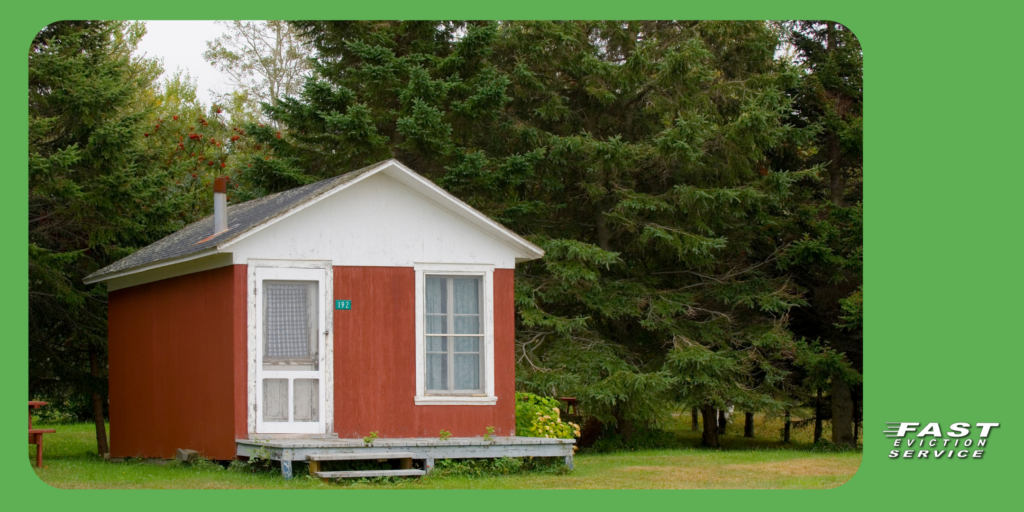You are represented at all times by one of our California Eviction Attorneys | 1-800-686-8686 | intake@fastevict.com | Se habla español
What Is an ADU? A California Landlord’s Complete Guide to Accessory Dwelling Units
California’s housing shortage has led to a sharp rise in interest in Accessory Dwelling Units (ADUs)—small, self-contained homes built on the same lot as a primary residence. For landlords, ADUs offer a unique opportunity to increase rental income, boost property value, and provide flexible housing solutions for multigenerational living. But while the rewards can be significant, navigating California’s ADU laws, costs, and zoning requirements is essential to avoid costly missteps.
Whether you’re exploring ADUs for the first time or considering converting a garage into a rental unit, this guide will walk you through everything California landlords need to know.
Key Takeaways
- An Accessory Dwelling Unit (ADU) is a secondary residential structure located on the same lot as a main home.
- ADUs can be detached, attached, or converted from existing space like a garage.
- California has specific laws regulating ADU construction, rental, and permitting timelines.
- ADUs can increase property value and generate consistent rental income.
- Costs, financing, local zoning rules, and tax implications should be evaluated before construction.

Table of Contents
- What Is an ADU?
- Types of ADUs
- California ADU Laws and Zoning Requirements
- How Much Does It Cost to Build an ADU?
- Financing Your ADU Project
- ADUs as Rental Units: ROI and Property Value
- Best Use Cases for ADUs
- ADU Planning Tips for California Landlords
- Step-by-Step ADU Development Checklist
- Common Challenges and Recent Trends
- Conclusion
What Is an ADU?
An Accessory Dwelling Unit (ADU), also called a granny flat, in-law suite, or backyard cottage, is a self-contained residential unit located on the same lot as a primary home. Unlike a duplex, an ADU cannot be sold separately—it remains part of the same property deed.
In California, ADUs are promoted as a solution to the affordable housing crisis. The state has streamlined laws to encourage landlords and homeowners to build ADUs, whether for family housing or long-term rental purposes.
Types of ADUs
ADUs come in different forms, each with its own construction requirements and cost implications:
- Detached ADUs: Standalone units, often built in a backyard. These offer the most privacy but are also the most expensive to construct.
- Attached ADUs: Built as an addition to the main home, often sharing at least one wall.
- Conversion ADUs: Repurposed spaces within the existing home or garage, such as a basement or attic.
- Junior ADUs (JADUs): Smaller units (max 500 sq ft) created within a single-family home with efficiency kitchens and independent entrances. California law permits both an ADU and a JADU on a single-family lot.
California ADU Laws and Zoning Requirements
California’s ADU laws have evolved rapidly in recent years to make development easier. As of 2025, key rules for landlords include:
- Permit Timelines: Local governments must approve or deny ADU applications within 60 days.
- Size Limits: Detached ADUs up to 1,200 sq ft are typically allowed. Attached ADUs can be up to 50% of the primary home’s square footage.
- Owner Occupancy: California lifted owner-occupancy requirements for new ADUs through 2025, allowing rental-focused landlords more flexibility.
- Setbacks and Height: Most lots allow a minimum 4-foot rear and side setback for detached units. Height limits vary by city but can be up to 16–20 feet.
- Parking Requirements: Parking mandates are waived in many cases, such as when the ADU is within half a mile of public transit.
- Rental Duration: Short-term rentals (less than 30 days) are often prohibited by local municipalities to encourage long-term housing use.
Local zoning ordinances still apply, and some cities add their own design guidelines. Always consult with the local planning department before beginning.
How Much Does It Cost to Build an ADU?
ADU construction costs vary depending on size, location, design, and whether the unit is detached or converted. On average:
- Garage conversions: $80,000–$130,000
- Attached ADUs: $100,000–$200,000
- Detached ADUs: $150,000–$300,000+
Other costs to consider:
- Permits and utility connection fees
- Architectural plans and engineering
- Landscaping or demolition
- Potential property tax reassessments
Construction time can range from 4 to 12 months depending on permitting, weather, and contractor availability.
Financing Your ADU Project
California landlords have several options for financing ADU construction:
- Cash-out refinance: Tap into home equity at relatively low interest rates.
- Home equity loan or HELOC: Ideal for phased builds or conversions.
- Renovation loans: FHA 203(k) or Fannie Mae Homestyle loans offer construction-to-permanent financing.
- Private ADU lenders: Some lenders specialize in ADU projects but may charge higher rates.
- Prefab ADU manufacturers: Many offer in-house financing for their models.
Landlords should weigh monthly payments, total costs, and rental income potential before choosing a financing option.
ADUs as Rental Units: ROI and Property Value
For many landlords, ADUs provide steady rental income without buying new property. In cities like Los Angeles, a 500–600 sq ft ADU can rent for $1,800 to $2,500 per month.
Return on Investment (ROI) can be calculated by:
(Annual Rent Income – Annual Expenses) ÷ Total Project Cost = ROI
Beyond income, ADUs typically increase property value, especially in areas where additional units are rare. According to FHFA, California homes with ADUs have shown higher long-term value appreciation.
However, added value can trigger higher property taxes, so consult a tax professional before breaking ground.
Best Use Cases for ADUs
Landlords use ADUs for a variety of purposes:
- Long-term rentals: Generate reliable monthly income.
- Housing family members: Elderly parents, adult children, or live-in caregivers.
- Home offices or guest houses: For those who need extra, private space.
- Future downsizing: Landlords may choose to live in the ADU and rent out the primary residence later.
Flexibility is one of the biggest advantages of an ADU.
ADU Planning Tips for California Landlords
To streamline your ADU project:
- Start with a feasibility study: Assess zoning, lot size, setbacks, and utility access.
- Hire professionals: Work with architects or ADU-experienced designers familiar with local regulations.
- Get written estimates: Account for contingencies and hidden fees.
- Engage early with local planners: Avoid delays due to missing paperwork or interpretation of zoning laws.
- Plan for inspections: Final occupancy approvals require compliance with fire, safety, and structural codes.
Step-by-Step ADU Development Checklist
- Confirm zoning and lot eligibility
- Choose ADU type (detached, attached, conversion)
- Design the unit and apply for permits
- Secure financing or budget allocation
- Hire licensed contractor(s)
- Construct and complete inspections
- Obtain certificate of occupancy
- Advertise and screen tenants (if renting)
Common Challenges and Recent Trends
Despite legislative support, landlords may face:
- Delays from local utility companies
- Neighborhood resistance due to parking or privacy concerns
- Construction cost inflation
- Regulatory confusion from city-to-city variation
Recent trends:
- More cities allowing ADU condos for sale under AB 1033.
- Rise in prefab ADU models for faster installation.
- Landlords maximizing returns by building multiple ADUs on multifamily lots.
Conclusion
California landlords are uniquely positioned to benefit from the state’s push for more ADUs. Whether you’re looking to boost your rental income or add long-term value to your property, understanding the legal, financial, and construction aspects of ADUs is critical. With the right strategy and compliance, an ADU can be one of the smartest investments you make as a landlord.
